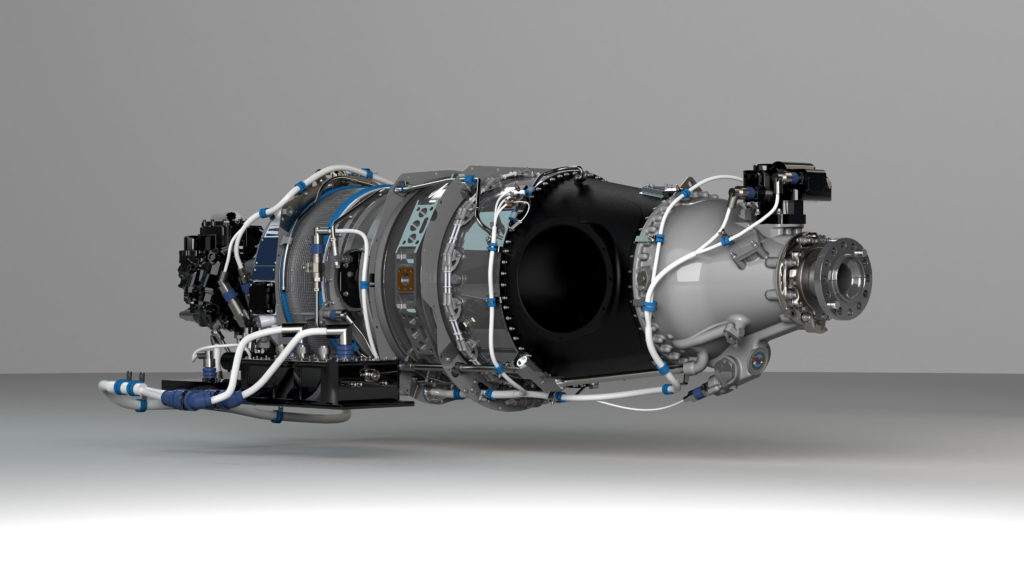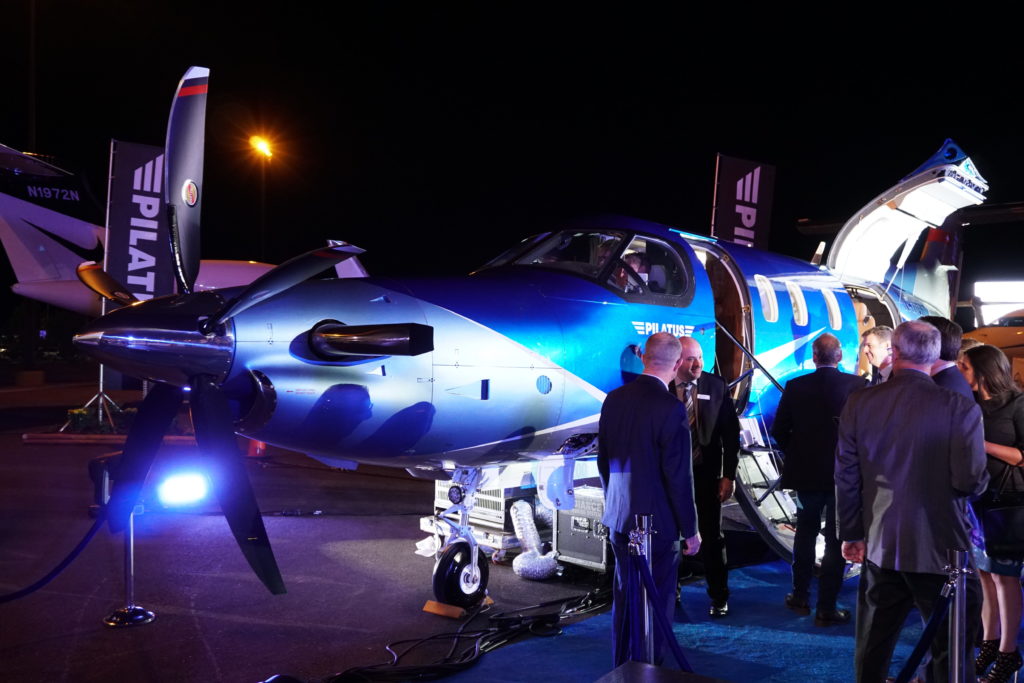Estimated reading time 12 minutes, 26 seconds.
Hard on the heels of its success with the clean sheet PC-24 business jet, Pilatus Aircraft of Switzerland has unveiled a new and improved version of its PC-12 single-engine turboprop.
The third generation PC-12 NGX made its debut on Oct. 21 at the National Business Aviation Association’s 2019 Business Aviation Conference & Exhibition (NBAA-BACE) in Las Vegas, Nev. Pilatus hosted an invitation-only reception at its static display booth at Henderson Executive Airport, where the manufacturer introduced the latest iteration of its workhorse single to industry and the media.

Since it first flew in 1991, the Pilatus PC-12 has earned a reputation for dependable versatility. More than 1,700 have been delivered to date, with the worldwide fleet logging in excess of 7.5 million flight hours. A significant percentage of these aircraft is found in Canada, where more than 100 PC-12s are flying.
Powered by the reliable Pratt & Whitney Canada PT6A-67P turboprop engine, the PC-12 NG — the NGX’s immediate predecessor — is currently tasked with a wide variety of missions, from medevacs to corporate travel to private operations, and is capable of accessing 21,300 paved, grass, dirt or gravel runways around the world. Pilatus has dubbed the aircraft “the world’s greatest single.”
Since the Swiss manufacturer has been busy designing and launching its new PC-24 twin-engine business jet, which entered service in February 2018, you might assume the PC-12 hasn’t been getting much attention.
But you would be mistaken. In fact, the PC-12 NGX has actually been in development for more than three years, with flight testing ongoing since December 2017. It achieved certification from the European Union Aviation Safety Agency (EASA) on Oct. 15, 2019.
“It’s easy when you’re number one in the category to stay stagnant, but Pilatus has this culture of constant improvement,” said Stan Kuliavas, vice-president of Sales and Business Development at Thunder Bay, Ont.-based Levaero Aviation, Canada’s exclusive Pilatus distributor.

“When we were informed about it at the international sales meeting in Switzerland [in mid-September], it was a very pleasant surprise, but not a shock,” he continued. “Pilatus is always innovating with the end owner in mind.”
At that meeting, Kuliavas had the opportunity to fly in the new PC-12 NGX.
The first thing he noticed was the aircraft’s larger windows. Inspired by those on the PC-24, they are now 10 per cent bigger and have been reshaped to allow more natural light into the cabin.
“The interior appointment of the cabin was next level, state-of-the-art modern,” continued Kuliavas.

“The seat design has completely changed. The comfort factor has reached that next level, very similar to what you’d find in a PC-24. Relative to anything in its category, this new PC-12 absolutely crushes them.”
Faster, yet quieter
Propelling the PC-12 NGX to its maximum cruise speed of 290 KTAS — five knots faster than the PC-12 NG — is Pratt & Whitney Canada’s new PT6E-67XP turboprop engine.
Controlled through a single power lever, the engine incorporates a number of advanced technologies. According to Nicholas Kanellias, vice-president of General Aviation at Pratt & Whitney Canada, it is the segment’s first dual-channel integrated electronic propeller and engine control system. The new engine was developed at the company’s plant in Longueuil, Que.
“We are extremely pleased and proud to be announcing the launch of the new PT6 E-series engine,” said Kanellias, who attended the Pilatus reception on Oct. 21. “People kept asking when this would be unveiled. But it’s not as simple as putting an electronic control on a PT6.

The vision at the beginning was to offer a whole new experience for our customers, very different from what we’ve done before. In essence, it is an engine performance system coupled with a control service system.”
The PT6E-67XP is being launched on the Pilatus PC-12 NGX. Kanellias said it was designed with pilots, owners and operators in mind.
“For pilots, they get to experience a more intuitive way of flying,” he explained. “Operations they have to perform are simplified. They can start or stop the engine with the push of a button, and a single lever controls all the different aspects of how you operate the engine.
“At the same time, you’re optimizing the engine performance through all phases of flight. There is no mechanical backup. It is a dual channel configuration — with two independent channels that are able to make adjustments to optimize and deliver the right engine power throughout all phases of flight — with auto-throttle to improve efficiency. We also thought about how to make prop control very easy. It can switch very easily between speeds, so you can operate at 1,550 rpm versus the 1,700 rpm prop speed on the previous PT6A.”
The slower propeller speed translates into quieter operations for passengers in the cabin.
Owners and operators will also benefit from an engine that will assist in faster, more streamlined operations. Kanellias said the engine allows for a 10 per cent power increase, and a 15 per cent reduction in hourly operating costs for customers who enrol in the Eagle Service Plan (ESP).
“For maintainers, we’ve doubled the scheduled maintenance intervals to 600 hours. The TBO [time between overhauls] has gone up 43 per cent to 5,000 hours out of the box. There is no mechanical rigging. It’s a much simpler engine, with fewer parts to maintain. This results in a 40 per cent reduction in scheduled line maintenance.”
Currently, FlightSafety International provides aircraft maintenance personnel with PT6 engine training. Kanellias said that if an engineer has taken the existing course, it will be “a relatively simple process to learn this engine.”
Pratt & Whitney Canada is also offering an enhanced service plan for the new engine — one that covers 50 per cent more items than existing PT6 programs.
“It’s a digital engine, digitally connected to optimize performance,” said Kanellias. “Everything is monitored, everything is connected. All info from a flight gets downloaded and the customer gets our predictive analytics and proactive service plan kicking in.”
The PT6E-67XP has been certified by Transport Canada, EASA and the U.S. Federal Aviation Administration.
Up front operations
Like earlier PC-12s, the PC-12 NGX will be certified for single pilot operations.

Flying is streamlined through the aircraft’s Advanced Cockpit Environment (ACE), powered by Honeywell’s Epic 2.0 technology.
Jason Bialek, Honeywell’s product line director for the Primus Epic avionics suite, explained how the PC-12 NGX flight deck offers more than ever before.
“We focused on providing some additional features that are helpful for single pilots, VFR [visual flight rules] and off-airport ops,” he told Skies. “Single pilot ops are often more critical at night and at unfamiliar airports, and there are also physiological issues, such as hypoxia at high altitudes.”
The Epic 2.0 package incorporates a number of safety features, including optional auto-throttle for the PC-12 NGX (this is the first time Honeywell has incorporated auto-throttle with a FADEC-controlled engine and propeller combination).
Bialek said Honeywell concentrated on lessening the workload for pilots in both climbs and descents.
“If you were in a climb and you level off, or a descent and you level off, it maintains that speed for you,” he said.
A new emergency descent mode will automatically initiate a descent when cabin pressure is lost. This is an especially attractive feature for owners who will be flying with their families or other non-pilots, said Bialek.
Finally, tactile feedback allows the aircraft to recognize when it is overbanked.
“This is activated at 51 degrees of bank. If the pilot does nothing, it will roll to a safe bank angle of about 30 degrees. But if the pilot really does need that degree of bank, they can override it. Tactile feedback is also annunciated to the pilots.”
Bright and intuitive touch screen controls incorporate contoured grips that stabilize the pilot’s hand in turbulence, added Bialek.
At the same time, Honeywell has retained the cursor control display (CCD). Screen and menu layouts are optimized for single pilot operations. The combination of touch screen and CCD is unique to the PC-12 NGX.
In fact, Bialek said the single-engine turboprop’s avionics suite is very similar to that found in its larger twinjet sibling, the PC-24.
“The systems and synoptics are different due to engine differences. But if you’re comfortable in a PC-12 NGX, the avionics transition to a PC-24 will be smooth.”
Honeywell and Pilatus worked together for years to optimize the avionics package in the PC-12 NGX, concluded Bialek. He said features that are typically industry options are now standard, including a flight management system (FMS), dual GPS and visual approach assistance.
Unveiling the NGX
With EASA’s stamp of approval already in hand, Pilatus is targeting U.S. certification for the PC-12 NGX by the end of this year. Customer deliveries are expected to begin as soon as the second quarter of 2020.

Speaking at the NBAA media event, Pilatus CEO Markus Bucher said he was excited to finally reveal the new aircraft.
“The PC-12 NGX is a showcase for the advanced technology collaboration between Pilatus, Pratt & Whitney Canada and Honeywell,” he said. “Together, we took the best and made it even better.”
For his part, Levaero’s Stan Kuliavas is looking forward to introducing Canadians to the PC-12 NGX, hopefully at the Canadian Business Aviation Association (CBAA) convention in Toronto next June.
“If we have one available at the time, it will be there,” he said.
The base price of the PC-12 NGX is US$4.39 million, with a typical executive configuration priced at US$5,369,000.








